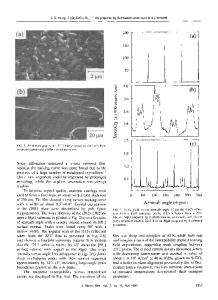Crystalline Phases During the Melting of Bi 2 Sr 2 CaCu 2 O X
- PDF / 1,015,870 Bytes
- 5 Pages / 420.48 x 639 pts Page_size
- 44 Downloads / 358 Views
CRYSTALLINE PHASES DURING THE MELTING OF Bi 2 Sr 2 CaCu 2 0O MING XU1, J. POLONKA 2 , A. I. GOLDMAN 1, D. K. FINNEMORE 1, QIANG LI 1, 3 AND F. C. LAABS Ames Laboratory, U.S. Department of Energy and 1Department of Physics and Astronomy, 2 Department of Chemistry, and 3 Department of Materials Science and Engineering, Iowa State University, Ames, IA 50011 ABSTRACT The melting of Bi 2 Sr 2 CaCu 2 0x material has been studied by scanning electron microscopy (SEM) and energy dispersive spectroscopy (EDS) in order to study the phases that formed in the high temperature regions. Two distinct phases of (Sri. xCax)CuO2 and (Srj-xCax)2CuO3 have been observed in the Bi-rich matrix depending upon quenching temperatures. Crystallization from the melt by fast cooling usually produce the co-existence of Bi (2201) and these Sr-Ca-Cu-O phases. Introduction High Tc Bi-Sr-Ca-Cu-O superconductors may have great potential in practical applications. Considerable interest has been raised in the many phases that form at higher temperatures in the fabrication of the high quality Bi (2212) or Bi (2223) superconductors [1-4]. In recent studies of high temperature x-ray diffraction [5-7], it has been shown that upon melting Bi (2212) material several different insulating phases appear in the liquid during the melting process. Oka et al. first reported that two phases of (Srj-xCax)CuO2 and (Srl-xCax)2CuO3 were observed in the melted state depending upon the starting compositions of Bi (2212) and Bi (4336) [5]. But, it is unclear how these phases form. The purpose of this work is to study the crystallization behavior, the phase formation, and the factors controlling the phase growth during the melting at high temperatures in Bi (2212) system. The phases present in the melted state have been investigated by scanning electron microscopy and energy dispersive spectrometer. Experimental The Bi (2212) "materials used in the high temperature x-ray diffraction experiments were prepared using a solid state reaction technique reported elsewhere [3]. The sample crucible is a Pt strip about 0.15 mm thick, 10 mm wide, and 100 mm long with an indentation about 8 mm by 8 mm in the center to hold the Bi (2212) powder. The samples were quenched from high temperatures by switching off the power supply, while either (Srj_xCax)CuO 2 phase or (Sr 1 _ xCax)CuO 2 phase diffraction peaks was observed in the high temperature x-ray detector. More detailed description of high temperature x-ray diffraction work can be found in Ref. [8]. Microstructure and phase composition were examined by a Cambridge S-200 scanning electron microscope (SEM) equipped with a Tracor-Northern energy dispersive spectrometer (EDS) and operated at 15 kV. Mat. Res. Soc. Symp. Proc. Vol. 249. 41992 Materials Research Society
176
Chemical analysis was carried out on the EDS spectrum with standardless semiquantitative analysis (SSQ) program. Results and discussion Extensive SEM and EDS studies have done on the samples quenched from high temperatures in air. The first sample was quenched from a
Data Loading...











